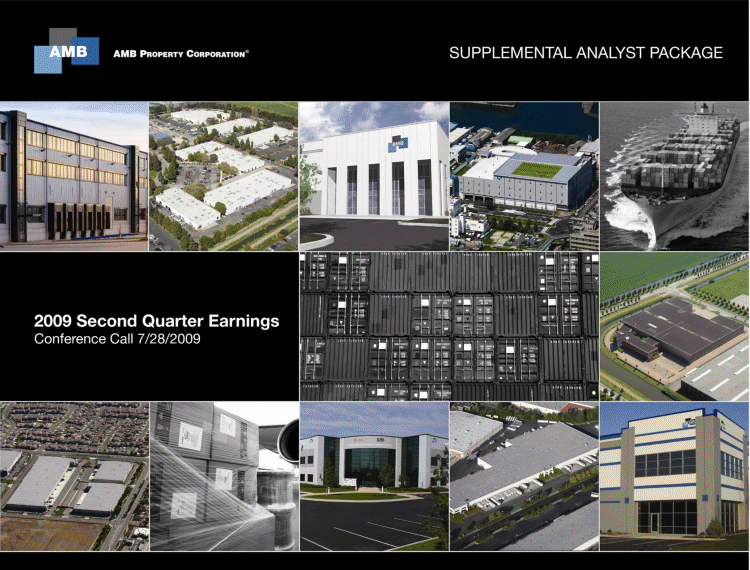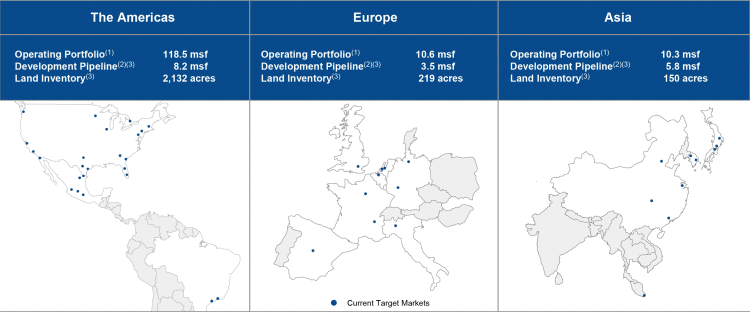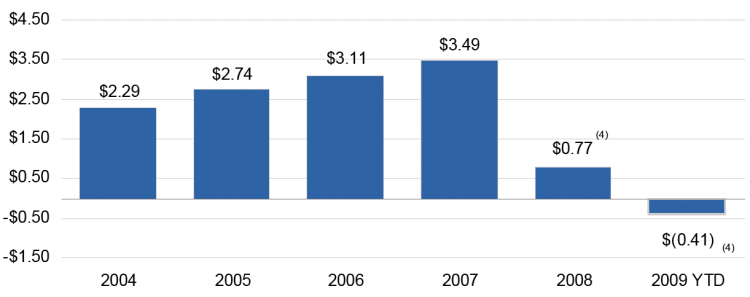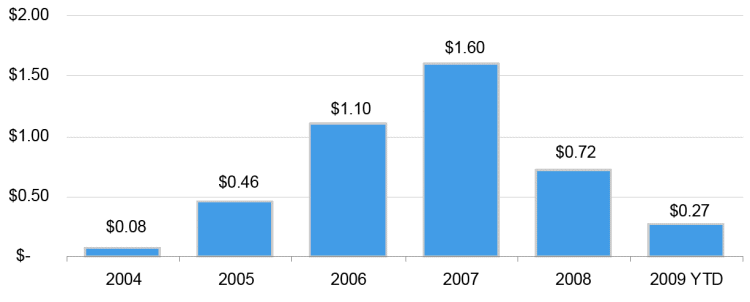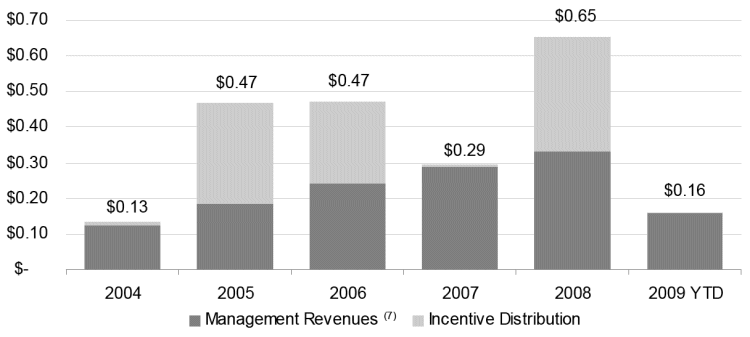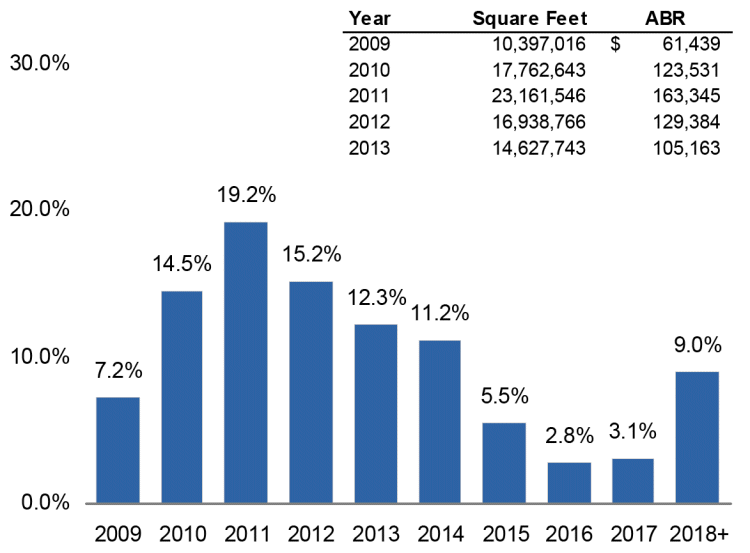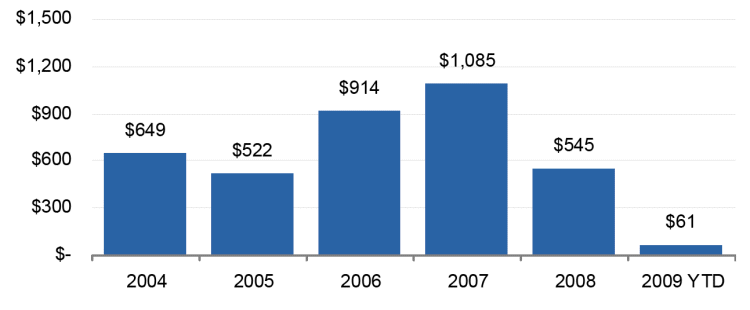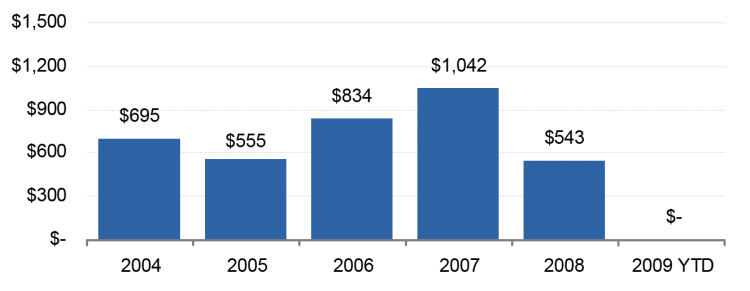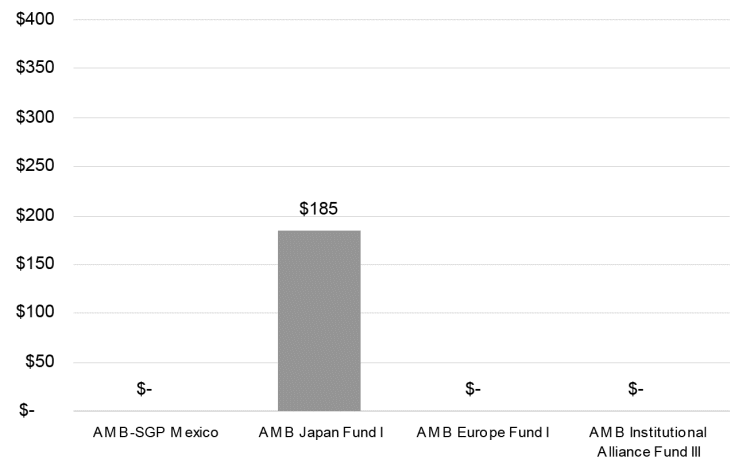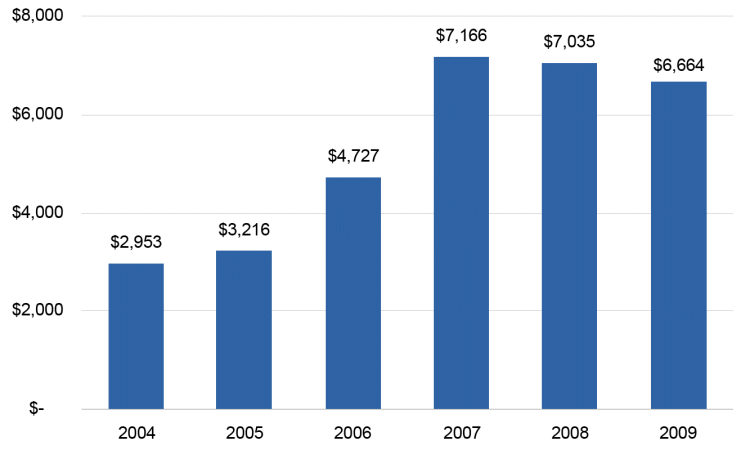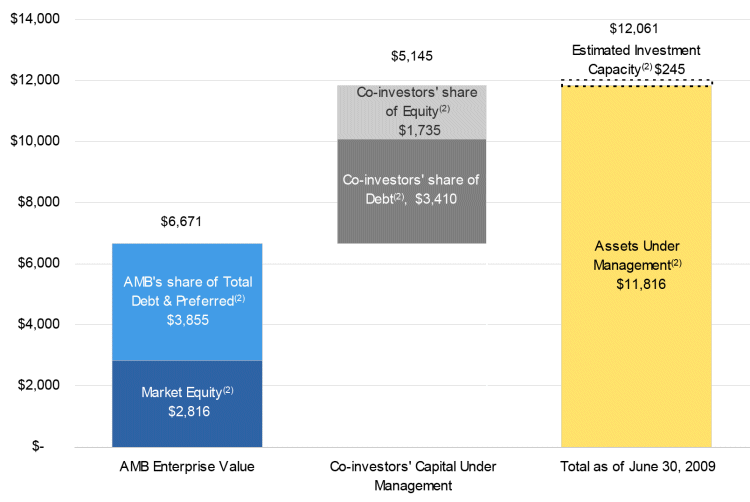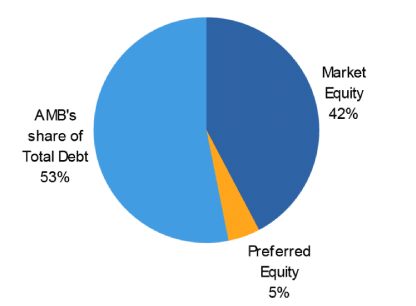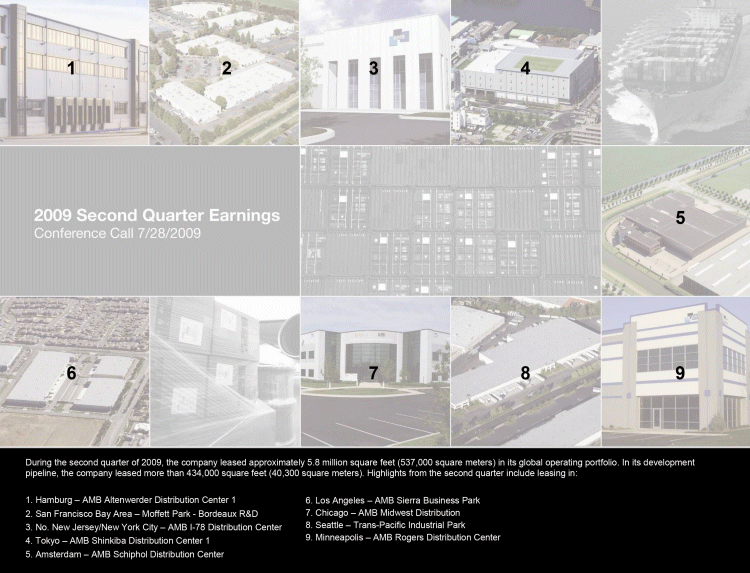| | | | | |
| | Company Profile | | SUPPLEMENTAL ANALYST PACKAGE
2009 Second Quarter Earnings Conference Call |
| |
AMB Property Corporation®is a leading owner, operator and developer of industrial real estate, focused on major hub and gateway distribution markets in the Americas, Europe and Asia. As of June 30, 2009, AMB owned or had investments in, on a consolidated basis or through unconsolidated joint ventures, properties and development projects expected to total approximately 156.9 million square feet (14.6 million square meters) in 48 markets within 14 countries.
AMB invests in properties located predominantly in the infill submarkets of its targeted markets. AMB’s portfolio is comprised primarily of High Throughput Distribution®facilities built for efficiency and located near airports, seaports, ground transportation systems, and population concentrations.
Through its private capital group, AMB provides real estate investment, portfolio management and reporting services to co-investment ventures and clients. The private capital revenue consists of asset management distributions and fees, acquisition and development fees as well as incentive distributions.
| | |
| (1) | | The operating portfolio includes the owned and managed portfolio and operating properties held through AMB’s investments in unconsolidated joint ventures that it does not manage (excluded from the owned and managed portfolio) and the location of AMB’s global headquarters. |
| (2) | | Includes development properties available for sale or contribution.
|
| (3) | | Includes investments held through unconsolidated joint ventures. |
| | | | | | | | | |
| Overview | Financial Results | Operations | Capital Deployment | Private Capital | Capitalization | NAV | Reporting Definitions | 1 |
| | | | | |
| | Reporting Definitions / Supplemental Financial Measures | | SUPPLEMENTAL ANALYST PACKAGE
2009 Second Quarter Earnings Conference Call |
| |
Acquisition Cost includes estimated acquisition capital expenditures. Estimated acquisition capital expenditures include immediate building improvements that are taken into consideration when underwriting the purchase of a building or which are incurred to bring a building up to operating standard or to stabilization and incremental building improvements and leasing costs that are incurred in an effort to substantially increase the revenue potential of an existing building.
Adjusted EBITDA. AMB uses adjusted earnings before interest (including the amount of capitalized interest deducted from the determination of development gains), tax, depreciation and amortization, impairment charges, restructuring and other non-cash charges, stock based compensation amortization, and non-development gains, or adjusted EBITDA, to measure both its operating performance and liquidity. AMB considers adjusted EBITDA to provide investors relevant and useful information because it permits investors to view income from its operations on an unleveraged basis before the effects of tax, non-cash depreciation and amortization expense or non-development gains. By excluding interest expense, adjusted EBITDA allows investors to measure AMB’s operating performance independent of its capital structure and indebtedness and, therefore, allows for a more meaningful comparison of its operating performance between quarters as well as annual periods and to compare its operating performance to that of other companies, both in the real estate industry and in other industries. AMB considers adjusted EBITDA to be a useful supplemental measure for reviewing its comparative performance with other companies because, by excluding non-cash depreciation expense, adjusted EBITDA can help the investing public compare the performance of a real estate company to that of companies in other industries. As a liquidity measure, AMB believes that adjusted EBITDA helps investors to analyze its ability to meet debt service obligations and to make quarterly preferred share dividends and unit distributions. Management uses adjusted EBITDA when measuring AMB’s operating performance and liquidity; specifically when assessing its operating performance, and comparing that performance to other companies, both in the real estate industry and in other industries, and when evaluating its ability to meet debt service obligations and to make quarterly preferred share dividends and unit distributions. AMB believes investors should consider adjusted EBITDA, in conjunction with net income (the primary measure of AMB’s performance) and the other required GAAP measures of its performance and liquidity, to improve their understanding of AMB’s operating results and liquidity, and to make more meaningful comparisons of its performance between periods and as against other companies. By excluding interest, taxes, depreciation and amortization, impairment charges, and non-development gains when assessing AMB’s financial performance, an investor is assessing the earnings generated by AMB’s operations, but not taking into account the eliminated expenses or non-development gains incurred in connection with such operations. As a result, adjusted EBITDA has limitations as an analytical tool and should be used in conjunction with AMB’s required GAAP presentations. Adjusted EBITDA does not reflect AMB’s historical cash expenditures or future cash requirements for working capital, capital expenditures or contractual commitments. Adjusted EBITDA also does not reflect the cash required to make interest and principal payments on AMB’s outstanding debt. While adjusted EBITDA is a relevant and widely used measure of operating performance and liquidity, it does not represent net income or cash flow from operations as defined by GAAP and it should not be considered as an alternative to those indicators in evaluating operating performance or liquidity. Further, AMB’s computation of adjusted EBITDA may not be comparable to EBITDA reported by other companies.
The following table reconciles adjusted EBITDA from net (loss) income for the three and six months ended June 30, 2009 and 2008 (dollars in thousands):
| | | | | | | | | | | | | | | | | |
| | | For the Quarters Ended | | | For the Six Months Ended | |
| | | June 30, | | | June 30, | |
| | | 2009 | | | 2008 | | | 2009 | | | 2008 | |
Net income (loss) | | $ | 29,034 | | | $ | 88,030 | | | $ | (94,322 | ) | | $ | 157,435 | |
| Depreciation and amortization | | | 38,724 | | | | 39,730 | | | | 80,460 | | | | 80,214 | |
| Impairment charges | | | — | | | | — | | | | 161,067 | | | | — | |
| Non-cash restructuring charges | | | 3,824 | | | | — | | | | 3,824 | | | | — | |
| Stock-based compensation amortization and other non-cash charges | | | 4,837 | | | | 5,094 | | | | 12,334 | | | | 11,623 | |
| Adjustments to derive adjusted EBITDA from unconsolidated joint ventures: | | | | | | | | | | | | | | | | |
| AMB’s share of net (income) loss | | | (4,284 | ) | | | (6,059 | ) | | | (4,250 | ) | | | (8,987 | ) |
| AMB’s share of FFO | | | 11,786 | | | | 12,276 | | | | 19,310 | | | | 21,138 | |
| AMB’s share of interest expense | | | 10,449 | | | | 4,810 | | | | 20,113 | | | | 10,731 | |
| Interest expense, including amortization | | | 29,329 | | | | 36,532 | | | | 61,986 | | | | 67,603 | |
| Total discontinued operations, including gains | | | (14,544 | ) | | | (5,167 | ) | | | (18,020 | ) | | | (30,588 | ) |
| Adjusted EBITDA attributable to noncontrolling interests | | | (14,461 | ) | | | (24,257 | ) | | | (29,570 | ) | | | (57,107 | ) |
| Capitalized interest attributable to development properties sold or contributed | | | 1,925 | | | | 8,438 | | | | 11,899 | | | | 11,786 | |
| Discontinued operations’ adjusted EBITDA | | | 5,076 | | | | 5,164 | | | | 12,216 | | | | 10,286 | |
| | | | | | | | | | | | | |
Adjusted EBITDA | | $ | 101,695 | | | $ | 164,591 | | | $ | 237,047 | | | $ | 274,134 | |
| | | | | | | | | | | | | |
AMB’s share of calculations for certain financial measures represent the pro-rata portion of the applicable financial measure based on AMB’s percentage of equity interest in each of the consolidated and unconsolidated co-investment ventures accounted for in the applicable financial measure. AMB believes that “AMB’s share of” calculations are meaningful and useful supplemental measures, which enable both management and investors to assess the operations, earnings and growth of AMB in light of AMB’s ownership interest in its joint ventures and to compare the applicable measure to that of other companies. In addition, it allows for a more meaningful comparison of the applicable measure to that of other companies that do not consolidate any of their joint ventures. “AMB’s share of” calculations are not intended to reflect actual liability should there be a default under loans or a liquidation of the joint ventures. AMB’s computation of “AMB’s share of” measures may not be comparable to that of other real estate companies, as they may use different methodologies for calculating these measures.
AMB’s share of Other Balance Sheet Items. AMB believes that balance sheet information based on GAAP provides the most appropriate information about financial position. However, AMB considers balance sheet information reported on an owned and managed basis (such as AMB’s share of cash and cash equivalents and restricted cash, AMB’s share of accounts receivable (net) and other assets, AMB’s share of deferred rents receivable and deferred financing costs (net), and AMB’s share of accounts payable and other liabilities) to be useful supplemental measures to help the investors better understand AMB’s operating performance. See Reporting Definitions for definitions of “owned and managed” and “AMB’s share of.” AMB believes that AMB’s share of balance sheet items on an owned and managed basis helps management and investors make a comprehensive assessment of AMB’s total real estate portfolio and provides a better understanding of AMB’s operating activities. While such information is helpful to the investor, it does not provide balance sheet information as defined by GAAP and is not a true alternative to such GAAP measurements. Further, AMB’s computation of its share of balance sheet items on an owned and managed basis may not be comparable to that of other real estate companies, as they may use different methodologies for calculating these measures.
AMB’s share of total debt. AMB’s share of total debt is the pro rata portion of the total debt based on its percentage of equity interest in each of the consolidated and unconsolidated joint ventures holding the debt. AMB believes that its share of total debt is a meaningful supplemental measure, which enables both management and investors to analyze its leverage and to compare its leverage to that of other companies. In addition, it allows for a more meaningful comparison of its debt to that of other companies that do not consolidate their joint ventures. AMB’s share of total debt is not intended to reflect its actual liability should there be a default under any or all of such loans or a liquidation of the joint ventures. See Capitalization Detail for a reconciliation of total debt and AMB’s share of total debt.
AMB’s share of total debt-to-AMB’s share of total assets is calculated using the following definitions: AMB’s share of total debt is the pro rata portion of the total debt based on AMB’s percentage of equity interest in each of the consolidated and unconsolidated joint ventures holding the debt. AMB’s share of total assets is the pro rata portion of total assets based on AMB’s percentage of equity interest in each of the consolidated and unconsolidated joint ventures holding the assets.
AMB’s share of total debt-to-total market capitalization is calculated using the following definitions: AMB’s share of total debt is the pro rata portion of the total debt based on AMB’s percentage of equity interest in each of the consolidated and unconsolidated joint ventures holding the debt. AMB’s definition of “total market capitalization” is AMB’s share of total debt plus preferred equity liquidation preferences plus market equity. AMB’s definition of “market equity” is the total number of outstanding shares of AMB’s common stock and common limited partnership units multiplied by the closing price per share of its common stock as of the period end.
Annualized base rent (ABR) is calculated as monthly base rent (cash basis) per the lease, as of a certain date, multiplied by 12. If free rent is granted, then the first positive rent value is used. Leases denominated in foreign currencies are translated using the currency exchange rate at period end.
Assets Under Management is AMB’s estimate of the value of the real estate it wholly owns or manages through its consolidated and unconsolidated co-investment ventures or for clients of AMB Capital Partners. Assets under management is calculated by adding the co-investment venture partner’s or client’s share of the carrying value of its real estate investment to AMB’s share of total market capitalization.
| | | | | | | | | |
| Overview | Financial Results | Operations | Capital Deployment | Private Capital | Capitalization | NAV | Reporting Definitions | 23 |
| | | | | |
| | Reporting Definitions / Supplemental Financial Measures | | SUPPLEMENTAL ANALYST PACKAGE
2009 Second Quarter Earnings Conference Call |
| |
Average occupancy percentage represents the daily weighted occupancy of the total rentable square feet leased, including month-to-month leases, divided by total rentable square feet. Space is considered leased when the tenant has either taken physical or economic occupancy.
Carrying value is the sum of the most recent valuation of real estate investments plus subsequently incurred capital expenditures. Generally, each real estate investment is valued once a year.
Cash-basis NOI. Cash-basis NOI is defined as NOI less straight line rents and amortization of lease intangibles. AMB considers cash-basis NOI to be an appropriate and useful supplemental performance measure because cash basis NOI reflects the operating performance of the real estate portfolio excluding the effects of non-cash adjustments and provides a better measure of actual cash basis rental growth for a year-over-year comparison. However, cash-basis NOI should not be viewed as an alternative measure of financial performance since it does not reflect general and administrative expenses, interest expenses, depreciation and amortization costs, capital expenditures and leasing costs, or trends in development and construction activities that could materially impact results from operations. Further, cash-basis NOI may not be comparable to that of other real estate investment trusts, as they may use different methodologies for calculating cash-basis NOI.
For a reconciliation of NOI from net income for the three months ended June 30, 2009, refer to the SS NOI definition. The following table reconciles AMB’s share of cash-basis NOI from NOI for the quarter ended June 30, 2009 (dollars in thousands):
| | | | | |
| | | For the Quarter Ended | |
| | | June 30, 2009 | |
| NOI | | $ | 97,062 | |
| Straight-line rents and amortization of lease intangibles | | | (1,542 | ) |
| Consolidated joint venture cash NOI | | | (27,091 | ) |
| | | | |
| Wholly-owned property cash NOI | | | 68,429 | |
| AMB’s share of consolidated joint venture cash NOI | | | 12,372 | |
| AMB’s share of unconsolidated joint venture cash NOI | | | 21,769 | |
| AMB’s share of transaction adjustments | | | (8,180 | ) |
| | | | |
| AMB’s share of cash-basis NOI | | $ | 94,390 | |
| | | | |
Co-investment Ventures are Joint Ventures with institutional investors, managed by AMB from which AMB receives acquisition fees for third-party acquisitions, portfolio and asset management distributions or fees, as well as incentive distributions or promoted interests.
Co-investment venture partner’s (or co-investor’s) share of debt is the co-investment venture partner’s pro-rata portion of total debt.
Co-investment venture partner’s (or co-investor’s) share of equity is the pro-rata portion of the co-investment venture partner’s share of carrying value less the co-investment venture partner’s share of debt.
Completion/Stabilization is generally defined as properties that are 90% leased or properties that have been substantially complete for at least 12 months.
Development activities include ground-up development, redevelopments, renovations, land sales and value-added conversions.
Development margin is calculated as contribution value or disposition price less closing costs, minus estimated total investment and any deferred rents, taxes or third party promotes before any deferrals on contributions, divided by the estimated total investment.
Estimated FFO by Business. Estimated FFO by Business is FFO generated by AMB’s Real Estate Operations, Development and Private Capital business. Estimated Development and Private Capital FFO was determined by reducing Development Profits, net of taxes, and Private Capital revenues by their respective estimated share of general and administrative expenses, also defined as overhead. Development’s and Private Capital’s estimated allocation of total general and administrative expenses was based on their respective percentage of actual direct general and administrative expenses incurred. Estimated Real Estate Operations FFO represents total AMB FFO less estimated FFO attributable to Development and Private Capital. Management believes estimated FFO by business line is a useful supplemental measure of its operating performance because it helps the investing public compare the operating performance of AMB’s respective businesses to other companies’ comparable businesses. Further, AMB’s computation of FFO by business line may not be comparable to that reported by other real estate investment trusts as they may use different methodologies in computing such measures.
Estimated investment capacity is AMB’s estimate of the gross real estate which could be acquired through the use of its equity commitments from co-investment venture partners plus AMB’s funding obligations and estimated debt capitalization.
Estimated total investment represents total estimated cost of development, renovation, or expansion, including initial acquisition costs, prepaid ground leases, buildings, and associated carry costs. Estimated total investments are based on current forecasts and are subject to change. Non-U.S. Dollar investments are translated to U.S. Dollars using the exchange rate at period end.
Co-investment venture operating results.
| | | | | | | | | | | | | | | | | | | | | | | | | | | | | |
| For the Quarter Ended June 30, 2009 |
| | | | | | | | | | | | | | | Income | | | | | | |
| | | AMB’s | | | | | | Property | | (Loss) from | | | | | | |
| | | Ownership | | | | | | Operating | | Continuing | | Net | | | | |
| Unconsolidated Co-investment Ventures | | Percentage | | Revenues | | Expenses | | Operations | | Income (Loss) | | Cash NOI | | FFO |
| AMB Institutional Alliance Fund III | | | 19 | % | | $ | 69,204 | | | $ | (18,102 | ) | | $ | 3,317 | | | $ | 4,343 | | | $ | 48,332 | | | $ | 24,064 | |
| AMB Europe Fund I | | | 21 | % | | | 24,179 | | | | (4,988 | ) | | | 1,188 | | | | 1,188 | | | | 18,438 | | | | 9,219 | |
| AMB Japan Fund I | | | 20 | % | | | 23,950 | | | | (5,768 | ) | | | 3,635 | | | | 3,635 | | | | 18,018 | | | | 10,328 | |
| AMB-SGP Mexico | | | 22 | % | | | 9,819 | | | | (1,317 | ) | | | 739 | (1) | | | 739 | (1) | | | 7,011 | | | | 3,839 | |
| AMB DFS Fund I | | | 15 | % | | | — | | | | (118 | ) | | | (5,370 | ) | | | (5,370 | ) | | | (118 | ) | | | (5,370 | ) |
| | | | | | | | | | | | | | | | | | | | | | | | | | | | | |
Consolidated Co-investment Ventures | | | | | | | | | | | | | | | | | | | | | | | | | | | | |
| | | | | | | | | | | | | | | | | | | | | | | | | | | | | |
| AMB-SGP | | | 50 | % | | | 11,745 | | | | (3,423 | ) | | | 281 | | | | 281 | | | | 8,426 | | | | 3,647 | |
| AMB Institutional Alliance Fund II | | | 20 | % | | | 13,124 | | | | (3,324 | ) | | | 1,957 | | | | 5,829 | | | | 10,037 | | | | 5,585 | |
| AMB-AMS | | | 39 | % | | | 4,162 | | | | (920 | ) | | | 781 | | | | 781 | | | | 3,243 | | | | 1,906 | |
| | |
| (1) | | Excludes $3.8 million of interest expense on loans from co-investment venture partners. |
Co-investment venture partner’s share of calculations for certain financial measures represent the pro-rata portion of the applicable financial measure based on AMB’s co-investment venture partners’ percentage of equity interest in each of the consolidated or unconsolidated co-investment ventures accounted for in the applicable financial measure.
Estimated yields on development projects are calculated from estimated annual cash NOI following occupancy stabilization divided by the estimated total investment. Yields exclude value added conversion projects and are calculated on an after-tax basis for international projects.
Fixed charge coverage. Fixed charge coverage is defined as Adjusted EBITDA divided by fixed charges. Fixed charges consist of interest expense less joint venture partner’s share of interest expense and amortization of finance costs and debt premiums, from continuing and discontinued operations, plus AMB’s share of interest expense from unconsolidated joint venture debt, capitalized interest, preferred unit distributions and preferred stock dividends. AMB uses fixed charge coverage to measure its liquidity. AMB believes fixed charge coverage is relevant and useful to investors because it permits fixed income investors to measure AMB’s ability to meet its interest payments on outstanding debt, make distributions to its preferred unitholders and pay dividends to its preferred shareholders. AMB’s computation of fixed charge coverage may not be comparable to fixed charge coverage reported by other companies.
| | | | | | | | | |
| Overview | Financial Results | Operations | Capital Deployment | Private Capital | Capitalization | NAV | Reporting Definitions | 24 |
| | | | | |
| | Reporting Definitions / Supplemental Financial Measures | | SUPPLEMENTAL ANALYST PACKAGE
2009 Second Quarter Earnings Conference Call |
| |
The following table details the calculation of fixed charges for the three and six months ended June 30, 2009 and 2008 (dollars in thousands):
| | | | | | | | | | | | | | | | | |
| | | For the Quarters Ended | | | For the Six Months Ended | |
| | | June 30, | | | June 30, | |
| Fixed charge | | 2009 | | | 2008 | | | 2009 | | | 2008 | |
| Interest expense, including amortization — continuing operations | | $ | 29,329 | | | $ | 36,532 | | | $ | 61,986 | | | $ | 67,603 | |
| Amortization of financing costs and debt premiums — continuing operations | | | (3,033 | ) | | | (3,182 | ) | | | (6,207 | ) | | | (5,155 | ) |
| Interest expense, including amortization — discontinued operations | | | 41 | | | | (6 | ) | | | (190 | ) | | | (139 | ) |
| Amortization of financing costs and debt premiums — discontinued operations | | | (1 | ) | | | (3 | ) | | | (4 | ) | | | (7 | ) |
| Joint venture partner’s share of interest expense | | | (7,109 | ) | | | (10,192 | ) | | | (14,237 | ) | | | (24,489 | ) |
| AMB’s share of interest expense from unconsolidated joint ventures | | | 10,449 | | | | 4,810 | | | | 20,113 | | | | 10,731 | |
| Capitalized interest | | | 10,826 | | | | 17,168 | | | | 22,920 | | | | 34,927 | |
| Preferred unit distributions | | | 1,432 | | | | 1,432 | | | | 2,864 | | | | 2,864 | |
| Preferred stock dividends | | | 3,952 | | | | 3,952 | | | | 7,904 | | | | 7,904 | |
| | | | | | | | | | | | | |
Total fixed charge | | $ | 45,886 | | | $ | 50,511 | | | $ | 95,149 | | | $ | 94,239 | |
| | | | | | | | | | | | | |
Funds From Operations (“FFO”), Funds From Operations Per Share and Unit (“FFOPS”) and FFO, Excluding Impairment and Restructuring charges (together with FFO and FFOPS, the “FFO Measures”). AMB believes that net income, as defined by U.S. GAAP, is the most appropriate earnings measure. However, AMB considers funds from operations, or FFO, FFO per share and unit, or FFOPS, and FFO, excluding impairment charges, to be useful supplemental measures of its operating performance. AMB defines FFOPS as FFO per fully diluted weighted average share of AMB’s common stock and operating partnership units. AMB calculates FFO as net income available to common stockholders, calculated in accordance with U.S. GAAP, less gains (or losses) from dispositions of real estate held for investment purposes and real estate-related depreciation, and adjustments to derive AMB’s pro rata share of FFO of consolidated and unconsolidated joint ventures.
Unless stated otherwise, AMB includes the gains from development, including those from value-added conversion projects, before depreciation recapture, as a component of FFO. AMB believes that value-added conversion dispositions are in substance land sales and as such should be included in FFO, consistent with the real estate investment trust industry’s long standing practice to include gains on the sale of land in FFO. However, AMB’s interpretation of FFO or FFOPS may not be consistent with the views of others in the real estate investment trust industry, who may consider it to be a divergence from the NAREIT definition, and may not be comparable to FFO or FFOPS reported by other real estate investment trusts that interpret the current NAREIT definition differently than AMB does. In connection with the formation of a joint venture, AMB may warehouse assets that are acquired with the intent to contribute these assets to the newly formed venture. Some of the properties held for contribution may, under certain circumstances, be required to be depreciated under U.S. GAAP. If this circumstance arises, AMB intends to include in its calculation of FFO gains or losses related to the contribution of previously depreciated real estate to joint ventures. Although such a change, if instituted, will be a departure from the current NAREIT definition, AMB believes such calculation of FFO will better reflect the value created as a result of the contributions. To date, AMB has not included gains or losses from the contribution of previously depreciated warehoused assets in FFO.
In addition to presenting FFO as described above, AMB presents FFO, excluding impairment and restructuring charges. AMB calculates FFO, excluding impairment and restructuring charges, as FFO less impairment and restructuring charges and adjustments to derive AMB’s share of impairment charges from consolidated and unconsolidated joint ventures. To the extent that the book value of a land parcel or development asset exceeded the fair market value of a property, based on its intended holding period, a non-cash impairment charge was recognized for the shortfall. The impairment charges were principally a result of increases in estimated capitalization rates and deterioration in market conditions that adversely impacted values. The restructuring charges reflected costs associated with AMB’s reduction in global headcount and cost structure. Although difficult to predict, these charges may be recurring given the uncertainty of the current economic climate and its adverse effects on the real estate markets. While not infrequent or unusual in nature, these charges are subject to market fluctuations that can have inconsistent effects on AMB’s results of operations. The economics underlying these charges reflect market conditions in the short-term but can obscure the value of AMB’s long-term investment decisions and strategies. Management believes FFO, excluding impairment and restructuring charges, is significant and useful to both it and its investors because it more appropriately reflects the value and strength of AMB’s business model and its potential performance isolated from the volatility of the current economic environment. However, in addition to the limitations of FFO Measures generally discussed below, FFO, excluding impairment and restructuring charges, does not present a comprehensive measure of AMB’s financial condition and
operating performance. This measure is a modification of the NAREIT definition of FFO and should not be considered a replacement of FFO as AMB defines it or used as an alternative to net income or cash as defined by U.S. GAAP.
AMB believes that the FFO Measures are meaningful supplemental measures of its operating performance because historical cost accounting for real estate assets in accordance with U.S. GAAP implicitly assumes that the value of real estate assets diminishes predictably over time, as reflected through depreciation and amortization expenses. However, since real estate values have historically risen or fallen with market and other conditions, many industry investors and analysts have considered presentation of operating results for real estate companies that use historical cost accounting to be insufficient. Thus, the FFO Measures are supplemental measures of operating performance for real estate investment trusts that exclude historical cost depreciation and amortization, among other items, from net income available to common stockholders, as defined by U.S. GAAP. AMB believes that the use of the FFO Measures, combined with the required U.S. GAAP presentations, has been beneficial in improving the understanding of operating results of real estate investment trusts among the investing public and making comparisons of operating results among such companies more meaningful. AMB considers the FFO Measures to be useful measures for reviewing comparative operating and financial performance because, by excluding gains or losses related to sales of previously depreciated operating real estate assets and real estate depreciation and amortization, the FFO Measures can help the investing public compare the operating performance of a company’s real estate between periods or as compared to other companies. While FFO and FFOPS are relevant and widely used measures of operating performance of real estate investment trusts, the FFO Measures do not represent cash flow from operations or net income as defined by U.S. GAAP and should not be considered as alternatives to those measures in evaluating AMB’s liquidity or operating performance. The FFO Measures also do not consider the costs associated with capital expenditures related to AMB’s real estate assets nor are the FFO Measures necessarily indicative of cash available to fund AMB’s future cash requirements. Management compensates for the limitations of the FFO Measures by providing investors with financial statements prepared according to U.S. GAAP, along with this detailed discussion of the FFO Measures and a reconciliation of the FFO Measures to net income available to common stockholders, a U.S. GAAP measurement.
See Consolidated Statements of Funds from Operations for a reconciliation of FFO from net income available to common stockholders.
The following table reconciles projected FFO from projected net income available to common stockholders for the year ended December 31, 2009:
| | | | | | | | | |
| | | 2009 | |
| | | Low | | | High | |
| Projected net loss available to common stockholders | | $ | (0.68 | ) | | $ | (0.64 | ) |
| AMB’s share of projected depreciation and amortization | | | 1.20 | | | | 1.20 | |
| AMB’s share of projected gains on disposition of operating properties recognized to date | | | (0.18 | ) | | | (0.18 | ) |
| Impact of additional dilutive securities, other, rounding | | | (0.04 | ) | | | (0.04 | ) |
| | | | | | | |
Projected Funds From Operations (FFO) | | $ | 0.30 | | | $ | 0.34 | |
| | | | | | | |
| | | | | | | | | |
| AMB’s share of non-cash impairment charges | | | 1.32 | | | | 1.32 | |
| Restructuring charges | | | 0.03 | | | | 0.03 | |
| AMB’s share of development gains recognized to date | | | (0.24 | ) | | | (0.24 | ) |
| | | | | | | |
Projected FFO, excluding AMB’s share of non-cash impairment charges, restructuring charges and development gains(1) | | $ | 1.41 | | | $ | 1.45 | |
| | | | | | | |
Amounts are expressed per share, except FFO and FFO, excluding AMB’s share of non-cash impairment charges, restructuring charges and development gains, which is expressed per share and unit.
(1) As development gains are difficult to predict in the current economic environment, management believes Projected FFO, excluding AMB’s share of non-cash impairment charges, restructuring charges and development gains is the more appropriate and useful measure to reflect its assessment of AMB’s projected operating performance.
Gross operating margin is calculated as NOI divided by gross revenues (excluding straight-line rents and amortization of lease intangibles, reimbursable capital revenue and lease termination fees) for properties in the pool at period end.
| | | | | | | | | |
| Overview | Financial Results | Operations | Capital Deployment | Private Capital | Capitalization | NAV | Reporting Definitions | 25 |
| | | | | |
| | Reporting Definitions / Supplemental Financial Measures
| | SUPPLEMENTAL ANALYST PACKAGE
2009 Second Quarter Earnings Conference Call |
| |
Impairment charges represent the write down of assets due to estimated fair value being lower than carry value.
Interest coverage. Interest coverage is defined as adjusted EBITDA divided by AMB’s share of interest expense which consists of consolidated interest expense less joint venture partner’s share of interest expense, including amortization, from continuing and discontinued operations and AMB’s share of interest expense from unconsolidated joint venture debt. AMB uses interest coverage to measure its liquidity. AMB believes interest coverage is relevant and useful to investors because it permits investors to measure AMB’s ability to meet its interest payments on outstanding debt. AMB’s computation of interest coverage may not be comparable to interest coverage reported by other companies.
The following table details AMB’s share of total interest for the three and six months ended June 30, 2009 and 2008 (dollars in thousands):
| | | | | | | | | | | | | | | | | |
| | | For the Quarters Ended | | | For the Six Months Ended | |
| | | June 30, | | | June 30, | |
| Interest | | 2009 | | | 2008 | | | 2009 | | | 2008 | |
| Interest expense, including amortization — continuing operations | | $ | 29,329 | | | $ | 36,532 | | | $ | 61,986 | | | $ | 67,603 | |
| Interest expense, including amortization — discontinued operations | | | 41 | | | | (6 | ) | | | (190 | ) | | | (139 | ) |
| Joint venture partner’s share of interest expense | | | (7,109 | ) | | | (10,192 | ) | | | (14,237 | ) | | | (24,489 | ) |
| AMB’s share of interest expense from unconsolidated co-investment ventures | | | 10,449 | | | | 4,810 | | | | 20,113 | | | | 10,731 | |
| | | | | | | | | | | | | |
Total interest | | $ | 32,710 | | | $ | 31,144 | | | $ | 67,672 | | | $ | 53,706 | |
| | | | | | | | | | | | | |
Joint Ventures are all joint ventures, including Co-Investment Ventures, with real estate developers, other real estate operators, or institutional investors where AMB may or may not: have control, act as the manager and/or developer, earn asset management distributions or fees, or earn incentive distributions or promoted interests. In certain cases, AMB might provide development, leasing, property management and/or accounting services for which it may receive market compensation.
Joint venture partner’s share of calculations for certain financial measures represent the pro-rata portion of the applicable financial measure based on AMB’s joint venture partners’ percentage of equity interest in each of the consolidated or unconsolidated joint ventures accounted for in the applicable financial measure.
Market equity is defined as the total number of outstanding shares of AMB’s common stock and common limited partnership units multiplied by the closing price per share of its common stock at period end.
Net Asset Value (“NAV”). AMB believes NAV is a useful supplemental measure of its operating performance because it enables both management and investors to analyze the fair value of its business. An assessment of the fair value of a business involves estimates and assumptions and can be performed using various methods. AMB has presented certain financial measures related to its business that it believes may be useful to the investing public in calculating its NAV but has not presented any specific methodology nor provided any guidance on assumptions or estimates that should be used in the calculation.
Net Operating Income (“NOI”). See same store net operating income for discussion of NOI and a reconciliation of NOI from net income.
Occupancy percentage at period end represents the percentage of total rentable square feet leased, including month-to-month leases, divided by total rentable square feet at period end. Space is considered leased when the tenant has either taken physical or economic occupancy.
Owned and managed is defined by AMB as assets in which AMB has at least a 10% ownership interest, is the property or asset manager, and which it intends to hold for the long-term.
Owned and Managed Supplemental Cash Flow Information. AMB believes that cash flow information based on GAAP provides the most appropriate cash flow information. However, AMB considers cash flow information reported on an owned and managed basis (such as straight-line rents and amortization of lease intangibles, AMB’s share of straight-line rents and amortization of lease intangibles, gross lease termination fees, net lease termination fees, AMB’s share of net lease termination fees, tenant improvements, lease commissions and other lease costs, building improvements, Co-investment partners’ share of capital expenditures and AMB’s share of recurring capital expenditures) to be useful supplemental measures to help
the investors better understand AMB’s operating performance and cash flow. See Reporting Definitions for definitions of “owned and managed”, “AMB’s share of” and “Co-investment venture partners’ share of”. AMB believes that owned and managed cash flow information helps management and investors make a comprehensive assessment of the cash flow of AMB’s total real estate portfolio and provides a better understanding of AMB’s operating performance and activities. While owned and managed supplemental cash flow information is helpful to the investor, it does not provide cash flow information as defined by GAAP and are not true alternatives to such GAAP measurements. Further, AMB’s computation of owned and managed supplemental cash flow information may not be comparable to that of other real estate companies, as they may use different methodologies for calculating these measures.
Percent pre-leased represents the executed lease percentage of total square feet as of the reporting data.
Preferred, with respect to the capitalization ratios, is defined as preferred equity liquidation preferences.
Renovation projects represent projects where the acquired buildings are less than 75% leased and require significant capital expenditures (generally ranging from 10% — 25% of acquisition cost) to bring the buildings up to operating standards and stabilization (generally 90% leased).
Redevelopment projects represent those buildings that require significant capital expenditures (generally more than 25% of acquired cost or existing basis) to bring the buildings up to operating standards and stabilization (generally 90% leased).
Recurring capital expenditures represents non-incremental building improvements and leasing costs required to maintain current revenues. Recurring capital expenditures do not include estimated acquisition capital expenditures which were taken into consideration when underwriting the purchase of a building or which are incurred to bring a building up to operating standards.
Rent changes on renewals and rollovers are calculated as the difference, weighted by square feet, of the net ABR due the first month of a term commencement and the net ABR due the last month of the former tenant’s term. If free rent is granted, then the first positive full rent value is used as a point of comparison. The rental amounts exclude base stop amounts, holdover rent and premium rent charges. If either the previous or current lease terms are under 12 months, then they are excluded from this calculation. If the lease is first generation or there is no prior lease for comparison, then it is excluded from this calculation.
Same Store Net Operating Income, Cash-basis SS NOI (“SS NOI”) and Net Operating Income (“NOI”). AMB defines NOI as rental revenues, including reimbursements, less property operating expenses. NOI excludes depreciation, amortization, general and administrative expenses, restructuring charges, real estate impairment losses, development profits (losses), gains (losses) from sale or contribution of real estate interests, and interest expense. AMB believes that net income, as defined by GAAP, is the most appropriate earnings measure. However, NOI is a useful supplemental measure calculated to help investors understand AMB’s operating performance, excluding the effects of costs and expenses which are not related to the performance of the assets. NOI is widely used by the real estate industry as a useful supplemental measure, which helps investors compare AMB’s operating performance with that of other companies. Real estate impairment losses have been excluded in deriving NOI because AMB does not consider its impairment losses to be a property operating expense. AMB believes that the exclusion of impairment losses from NOI is a common methodology used in the real estate industry. Real estate impairment losses relate to the changing values of AMB’s assets but do not reflect the current operating performance of the assets with respect to their revenues or expenses. AMB’s real estate impairment losses are non-cash charges which represent the write down in the value of assets when estimated fair value over the holding period is lower than current carrying value. The impairment charges were principally a result of increases in estimated capitalization rates and deterioration in market conditions that adversely impacted underlying real estate values. Therefore, the impairment charges are not related to the current performance of AMB’s real estate operations and should be excluded from its calculation of NOI.
AMB considers SS NOI to be a useful supplemental measure of our operating performance for properties that are considered part of the same store pool. AMB defines Cash-basis SS NOI as NOI on a same store basis excluding straight line rents and amortization of lease intangibles. See definition of “same store pool.” AMB considers SS NOI to be an appropriate and useful supplemental performance measure because it reflects the
| | | | | | | | | |
| Overview | Financial Results | Operations | Capital Deployment | Private Capital | Capitalization | NAV | Reporting Definitions | 26 |
| | | | | |
| | Reporting Definitions / Supplemental Financial Measures
| | SUPPLEMENTAL ANALYST PACKAGE
2009 Second Quarter Earnings Conference Call |
| |
operating performance of the real estate portfolio excluding effects of non-cash adjustments and provides a better measure of actual cash basis rental growth for a year-over-year comparison. In addition, AMB believes that SS NOI helps investors compare the operating performance of AMB’s real estate as compared to other companies. While SS NOI is a relevant and widely used measure of operating performance of real estate investment trusts, it does not represent cash flow from operations or net income as defined by GAAP and should not be considered as an alternative to those measures in evaluating our liquidity or operating performance. SS NOI also does not reflect general and administrative expenses, interest expenses, real estate impairment losses, depreciation and amortization costs, capital expenditures and leasing costs, or trends in development and construction activities that could materially impact our results from operations. Further, AMB’s computation of SS NOI may not be comparable to that of other real estate companies, as they may use different methodologies for calculating SS NOI.
The following table reconciles consolidated cash-basis SS NOI and NOI from net income for the three and six months ended June 30, 2009 and 2008 (dollars in thousands):
| | | | | | | | | | | | | | | | | |
| | | For the Quarters Ended | | | For the Six Months Ended | |
| | | June 30, | | | June 30, | |
| | | 2009 | | | 2008 | | | 2009 | | | 2008 | |
| Net income (loss) | | $ | 29,034 | | | $ | 88,030 | | | $ | (94,322 | ) | | $ | 157,435 | |
| Private capital income | | | (7,795 | ) | | | (41,413 | ) | | | (19,490 | ) | | | (51,336 | ) |
| Depreciation and amortization | | | 38,724 | | | | 39,730 | | | | 80,460 | | | | 80,214 | |
| Real estate impairment losses | | | — | | | | — | | | | 161,067 | | | | — | |
| General and administrative and fund costs | | | 25,685 | | | | 34,128 | | | | 57,193 | | | | 69,475 | |
| Restructuring charges | | | 3,824 | | | | — | | | | 3,824 | | | | — | |
| Total other income and expenses | | | 22,134 | | | | (390 | ) | | | 27,943 | | | | (14,536 | ) |
| Total discontinued operations | | | (14,544 | ) | | | (5,167 | ) | | | (18,020 | ) | | | (10,621 | ) |
| | | | | | | | | | | | | |
| NOI | | | 97,062 | | | | 114,918 | | | | 198,655 | | | | 230,631 | |
| Less non same-store NOI | | | (11,487 | ) | | | (26,839 | ) | | | (24,030 | ) | | | (51,783 | ) |
Less non cash adjustments(1) | | | 844 | | | | (607 | ) | | | 853 | | | | (1,794 | ) |
| | | | | | | | | | | | | |
| Cash-basis same-store NOI | | $ | 86,419 | | | $ | 87,472 | | | $ | 175,478 | | | $ | 177,054 | |
| | | | | | | | | | | | | |
| | |
| (1) | | Non-cash adjustments include straight line rents and amortization of lease intangibles for the same store pool only. |
Same store NOI growth is the change in the NOI (excluding straight-line rents and amortization of lease intangibles) of the same store pool from the prior year reporting period to the current year reporting period.
Same store pool includes all properties that are owned as of the end of both the current and prior year reporting periods and excludes development properties for both the current and prior reporting periods. The same store pool is set annually and excludes properties purchased and developments stabilized after December 31, 2007.
Second generation TIs and LCs per square foot are total tenant improvements, lease commissions and other leasing costs incurred during leasing of second generation space divided by the total square feet leased. Costs incurred prior to leasing available space are not included until such space is leased. Second generation space excludes newly developed square footage or square footage vacant at acquisition.
Stabilized cap rates are calculated as cash NOI stabilized to market occupancy (generally 95%) divided by total acquisition cost. The total acquisition cost basis includes the initial purchase price, the effects of marking assumed debt to market, buyer’s due diligence and closing costs, lease intangible adjustments, estimated acquisition capital expenditures, and leasing costs necessary to achieve stabilization.
Tenant retention is the square footage of all leases rented by existing tenants divided by the square footage of all expiring and rented leases during the reporting period, excluding the square footage of tenants that default or buy-out prior to expiration of their lease, short-term tenants and the square footage of month-to-month leases.
Total market capitalization is defined by AMB as AMB’s share of total debt plus preferred equity liquidation preferences plus market equity (unless otherwise noted).
Value-added conversion projects represent the repurposing of industrial properties to a higher and better use, including office, residential, retail, research & development or manufacturing. Activities required to prepare the property for conversion to a higher and better use may include such activities as rezoning, redesigning, reconstructing and retenanting. The sales price of the value-added conversion project is generally based on the underlying land value based on its ultimate use and as such, little to no residual value is ascribed to the industrial building(s).
| | | | | | | | | |
| Overview | Financial Results | Operations | Capital Deployment | Private Capital | Capitalization | NAV | Reporting Definitions | 27 |
| | | | | |
| | Forward-Looking Statements
| | SUPPLEMENTAL ANALYST PACKAGE
2009 Second Quarter Earnings Conference Call |
| |
Some of the information included in this report and the presentations to be held in connection therewith contains forward-looking statements, such as those related to cash sources to cover future capital requirements, the consummation of asset sales marketed, under contract or LOI, our plans to retire, extend and refinance debt and maintain fixed charge coverage at certain levels, estimated cash savings from our current dividend policy, estimated net G&A reductions, our opportunities and plans (including those regarding our global positioning and future capital deployment), our projected funds from operations, compound annual growth rate of our business divisions, future assets under management, same store and/or cash net operating income and other financial and operational guidance, our capabilities to drive growth, our future performance compared to peers and other market indices, rent growth, industrial and other market, GDP and trade growth, market drivers, trends and forecasts, port opportunities (such as ship capacity expansion, outsourcing trends, port market demand, port expansions, container growth, and escalating land values), on-tarmac opportunities (such as air cargo growth, ability to access and leverage positions, and expertise and key airport opportunities), hiring, performance and retention of key personnel, access to resources, leveraging of relationships, continuation and effectiveness of strategic drivers, information regarding our development, value-added conversion, redevelopment and renovation projects (including stabilization dates, square feet at stabilization or completion, sale or contribution dates, yields from such projects, our share of remaining funding, costs and total investment amounts, scope, location and timing of development starts, margins, projected gains and returns, sustainability, profitability, scope and scale of and demand for projects, targeted value-added conversion projects, redevelopment and conversion timelines, entitlement and repositioning potential of land), ability to deliver customer solutions, strength of lender and customer relationships, lease expirations, performance and value-creation of investments and market entry opportunities, real estate valuations, capitalization rates, acquisition capital and volume, scope and build out potential of land inventory, co-investment venture and other estimated investment capacity, terms of the co-investment ventures, performance, revenues and returns on investment, target leverage, future incentive distribution, asset management, acquisition and other private capital distributions and fees, timing of incentive distributions, private capital demand, launching of additional funds, termination of funds, future balance sheet capacity, ability to maintain credit extensions, our position to address debt maturities, interest rate changes, transition to open-end funds, and access to secured and non-secured financings, which are made pursuant to the safe-harbor provisions of Section 21E of the Securities Exchange Act of 1934, as amended, and Section 27A of the Securities Act of 1933, as amended. Because these forward-looking statements involve risks and uncertainties, there are important factors that could cause our actual results to differ materially from those in the forward-looking statements, and you should not rely on the forward-looking statements as predictions of future events. The events or circumstances reflected in forward-looking statements might not occur. You can identify forward-looking statements by the use of forward-looking terminology such as “believes,” “expects,” “may,” “will,” “should,” “seeks,” “approximately,” “intends,” “plans,” “pro forma,” “estimates” or “anticipates” or the negative of these words and phrases or similar words or phrases. You can also identify forward-looking statements by discussions of strategy, plans or intentions. Forward-looking statements are necessarily dependent on assumptions, data or methods that may be incorrect or imprecise and we may not be able to realize them. We caution you not to place undue reliance on forward-looking statements, which reflect our analysis only and speak only as of the date of this report or the dates indicated in the statements. We assume no obligation to update or supplement forward-looking statements. The following factors, among others, could cause actual results and future events to differ materially from those set forth or contemplated in the forward-looking statements: defaults on or non-renewal of leases by tenants or renewal at lower than expected rent or failure to lease at all or on expected terms, decreases in real estate values and impairment losses, our failure to obtain, renew or extend financing or re-financing, risks related to debt and equity security financings (including dilution risk), our failure to divest properties we have contracted to sell or to timely reinvest proceeds from any divestitures, failure to maintain our current credit agency ratings or comply with our debt covenants, international currency and hedging risks, financial market fluctuations, changes in general economic conditions, global trade or in the real estate sector, inflation risks, a downturn in the U.S., California or global economy, increased interest rates and operating costs or greater than expected capital expenditures, risks related to suspending, reducing, or changing our dividends, our failure to contribute properties to our co-investment ventures, risks related to our obligations in the event of certain defaults under co-investment ventures and other debt, difficulties in identifying properties to acquire and in effecting acquisitions, our failure to successfully integrate acquired properties and operations, risks and uncertainties affecting property development, value-added conversions, redevelopment and construction (including construction delays, cost overruns, our inability to obtain necessary permits and public opposition to these activities), our failure to qualify and maintain our status as a real estate investment trust, risks related to our tax structuring, environmental uncertainties, risks related to natural disasters, changes in real estate and zoning laws, risks related to doing business internationally and global expansion, risks of opening offices globally, risks of changing personnel and roles, losses in excess of our insurance coverage, unknown liabilities acquired in connection with acquired properties or otherwise and increases in real property tax rates. Our success also depends upon economic trends generally, including interest rates, income tax laws, governmental regulation, legislation, population changes and certain other matters discussed under the heading “Risk Factors” and elsewhere in our annual report on Form 10-K for the year ended December 31, 2008.
